Hatching from what’s called an “egg pod” during the spring, a tiny nymph emerges.
Looking like a cartoon character, it has oversized, brown-to-black eyes and a translucent coloring that can range from green to brown. This little creature is a baby grasshopper.
Read on to learn seven amazing facts about these tiny insects that first appeared on Earth hundreds of millions of years ago.
1. Baby Grasshoppers Hatch in Huge Numbers
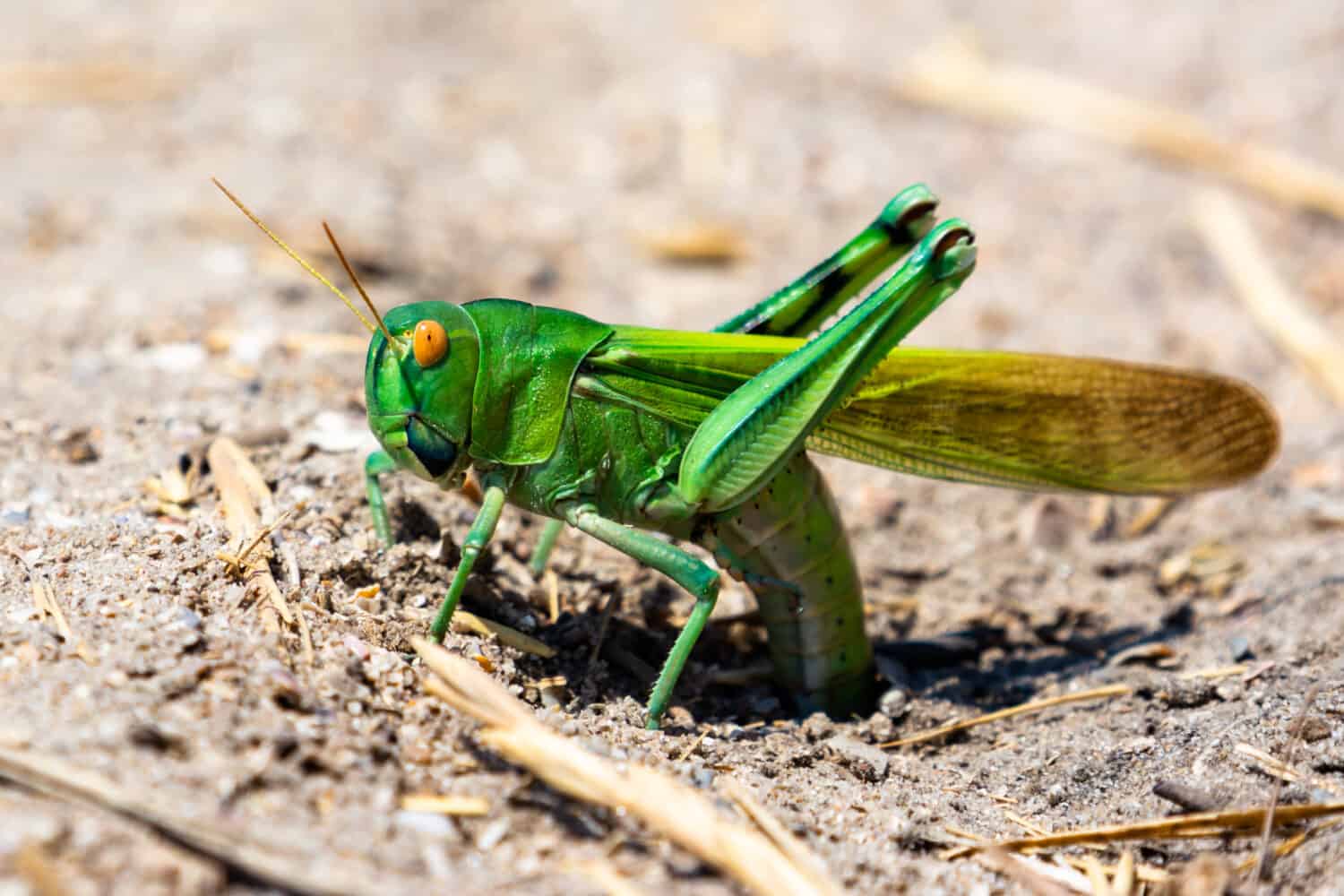
An adult green grasshopper laying eggs in the ground. A female can deposit hundreds of eggs during her short life.
©Elina Litovkina/Shutterstock.com
Grasshopper eggs are deposited in the late summer or fall into the soil contained in what’s called an “egg pod.” The number of eggs in an egg pod can vary from just a few to over 100, with several pods being produced.
The egg pod is very efficient at protecting and incubating the eggs over the winter. A lone female can lay hundreds of eggs, resulting in great masses of baby grasshoppers hatching the following spring.
2. Baby Grasshoppers Have No Wings

Grasshopper nymphs hatch with no wings, but in just a few weeks their wing pads will develop into wings.
©Tyler Fox/Shutterstock.com
Baby grasshoppers look like a miniature version of adult grasshoppers, with one big difference. They have no wings!
These insects go through three stages of development — the egg, the nymph, and the adult. Because of that, they are considered to mature with “incomplete metamorphosis.” To have a “complete” metamorphosis, there would have to be four well-defined developmental stages.
3. Baby Grasshoppers Are Called Nymphs
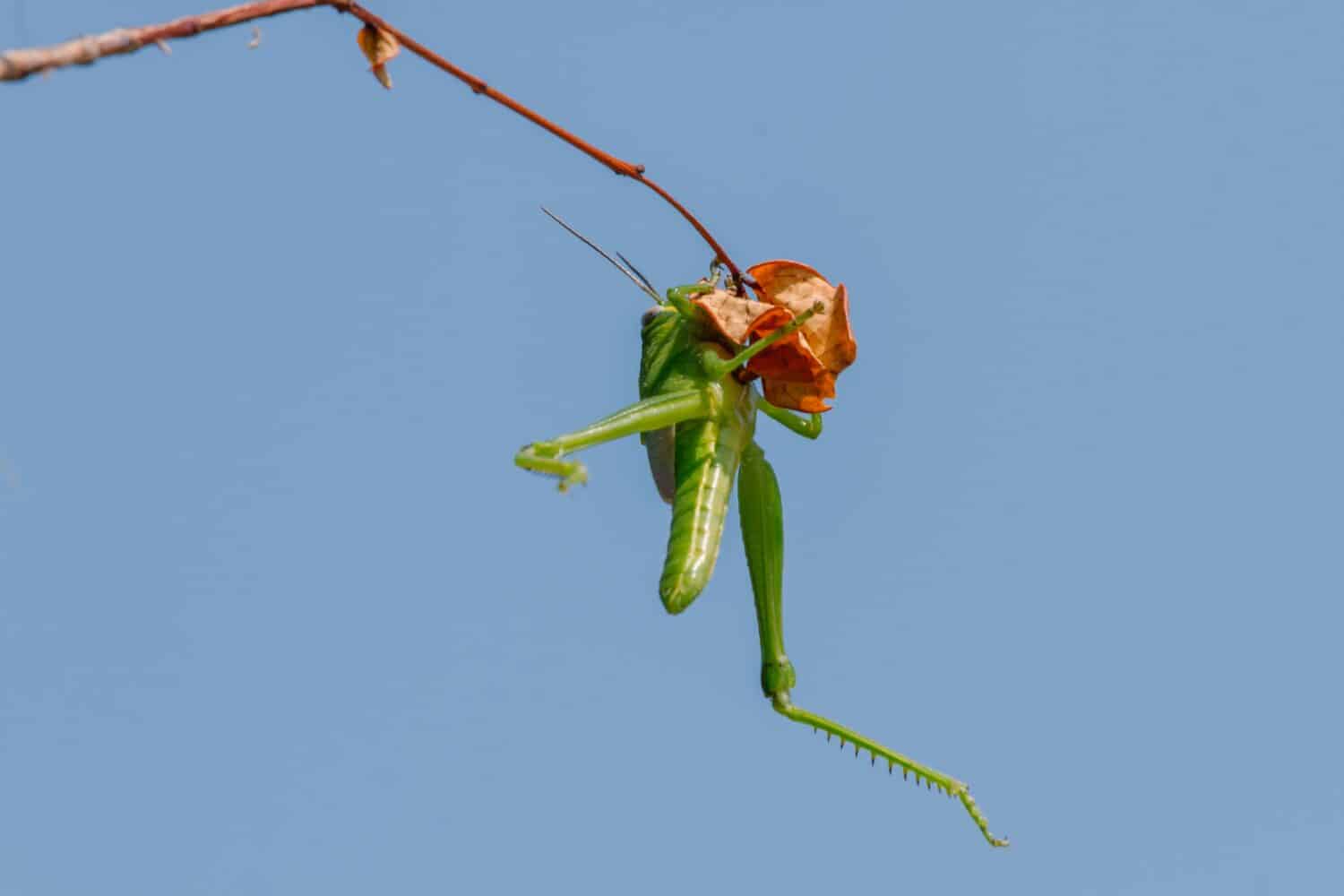
Nymphs start consuming vegetation almost immediately after hatching.
©Komodo Studios/Shutterstock.com
When grasshoppers first hatch they are called nymphs. During this stage of development, the nymph will molt up to six times. Each time one molts, it gets larger and starts to look more and more like an adult grasshopper.
Grasshoppers go from nymphs to adults in a little over a month. During this time, their wing pads develop into wings.
4. Where Are Baby Grasshoppers Found?

Grasshoppers hatch in the spring after incubating in an egg pod over the winter.
©K Abejuela/Shutterstock.com
Nymph grasshoppers will be found in dry areas with lots of grass and plants to feed on.
Drought conditions are the perfect environment for large numbers of grasshopper eggs to hatch and thrive. That’s because their egg pods are not apt to be disrupted when there’s no danger of flooding. A severe drought in the American West in 2021 resulted in a huge population increase of grasshoppers. The U.S. Department of Agriculture in its “grasshopper hazard map” measured a minimum of 15 of the insects per square yard of land in seven western states that year.
5. How Small Are Baby Grasshoppers?

Nymph grasshoppers are incredibly small and are often not seen unless you carefully check plants closely.
©Bill Roque/Shutterstock.com
Hatching at only 0.2 of an inch (5 millimeters) a just-hatched nymph will start feeding as soon as it’s out of the egg.
Being so small, the nymph may not be easy to see. The best way to find them is to carefully inspect plant material or leaf litter.
6. How Do Baby Grasshoppers Protect Themselves?
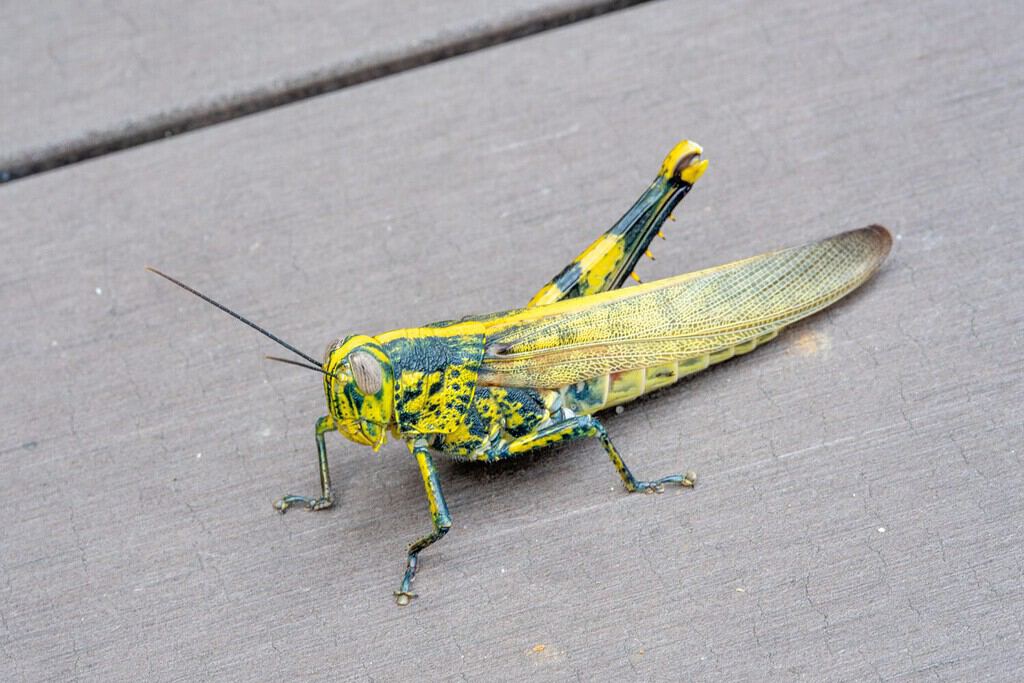
Grasshoppers are among the insects and reptiles that can ‘drop’ a limb if trapped. This adult is missing its rear leg.
©Jazreel Luar/Shutterstock.com
Nymphs can’t fly yet, but they can certainly hop! That’s one way to avoid being caught by a predator. Another, of course, is by hiding in leaf litter and grass.
But one of the more interesting ways that many grasshoppers protect themselves is by spitting brown liquid. This foul-tasting substance is mostly comprised of partially digested plant matter and stomach acid.
They also can shed one or both of their hind legs if trapped. This amazing process is called “autotomy.” The lost limb does not grow back, so this escape mechanism is only used under dire circumstances.
7. What Do Baby Grasshoppers Eat?
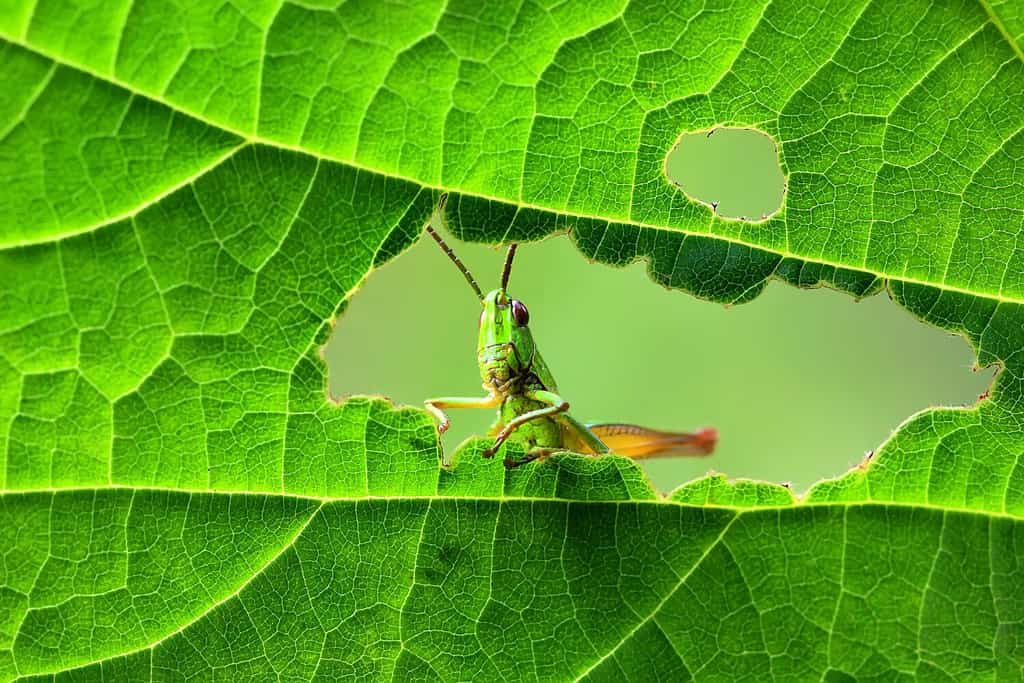
While there are certain plants and herbs that grasshoppers don’t like, for the most part, they will chomp through any above-ground greenery.
©Galina Gorkavay/Shutterstock.com
Young nymphs usually eat the same diet as adult grasshoppers do, any parts of plants that are above ground. After hatching, they must start eating as quickly as possible.
The survival rate of nymph grasshoppers is dictated by weather conditions. Long periods of cool weather in the spring, along with excessive rain, interfere with their ability to find food and may result in starvation.
More Fascinating Facts about Grasshoppers
What Are Locusts?
“Locust” can have several meanings depending on a particular geographical area. In North America, the terms grasshopper and locust are often used interchangeably. But there is a distinct difference.
Whether or not a grasshopper becomes a locust depends on its behavior. Grasshoppers are solitary creatures, but when conditions allow for larger-than-normal numbers, they can begin to “swarm.” Entomologists call this behavior “gregariousness,” and it’s quite dramatic. In the U.S. the Rocky Mountain locust invasion of 1873 caused chaos and devastation to numerous states. It was so extreme that it was called by a farmer of the day “a great white cloud, like a snowstorm blocking out the sun.”
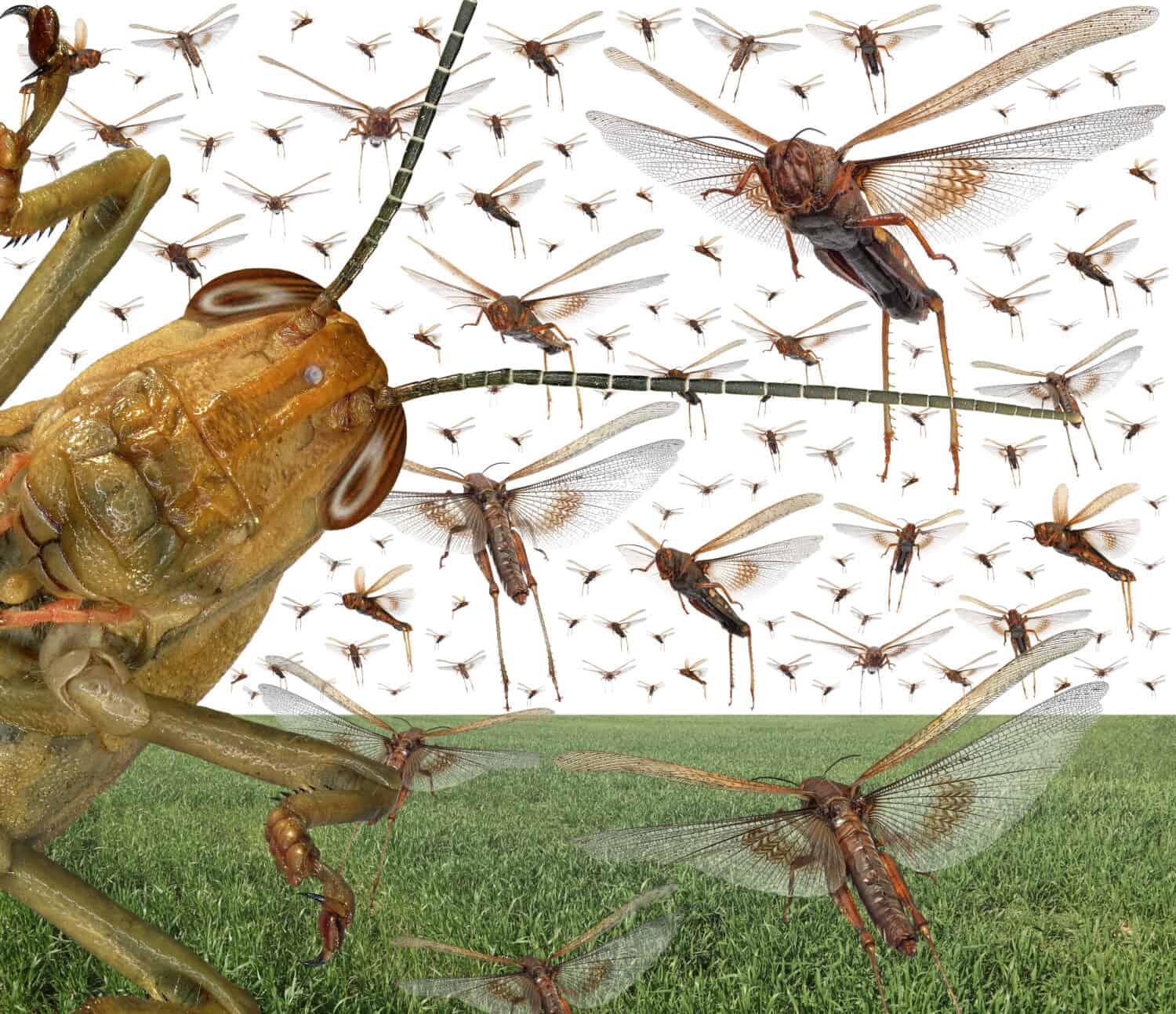
When swarming, grasshoppers are called locusts.
©Protasov AN/Shutterstock.com
Grasshoppers Evolved before the Dinosaurs
Grasshoppers have been on the Earth for a very long time! Primitive grasshoppers first evolved long before the dinosaurs, around 300 million years ago.
There are currently 11,000 known species found worldwide, except on the continent of Antarctica.
From Pests to Problem Solvers
Grasshoppers can pose a major threat to crops, especially during the nymph stage. But while grasshoppers consume plants, they are also consumed by humans!
In Mexico and Central America, where they are known as chapulines, they have been staples of people’s diets for thousands of years. These crunchy insects have found their way into gourmet dining as well.

Cooked and seasoned grasshoppers are called chapulines in Mexico and Central America.
©Marcos Castillo/Shutterstock.com
Beyond a snack or daring meal in an epicurean restaurant, however, grasshoppers are now being viewed by some as a solution to world hunger due to their exceptional nutritional profile. With a 40 percent protein content, these insects are also high in minerals such as zinc and calcium and numerous necessary vitamins. Unless you’re a vegan or vegetarian, you might just find grasshoppers to be an ideal food source.
Farm-raised grasshoppers are now said to be driving the “edible insect revolution.”
How to Keep Grasshoppers Away
Despite all the health benefits that grasshopper consumption may offer, they are typically uninvited guests in homes and gardens. There are, however, some easy ways to send them hopping.
Grasshoppers hate the smell of garlic, onions, and hot peppers. Blending up a combo of those aromatic odors, adding water, and spraying on garden greenery is one way to repel them.
Planting veggie or flowering plants that these ravenous insects dislike such as crepe myrtle, lilac, forsythia, garlic, and tomatoes, is also a good way of keeping them out of your garden. Other effective repellants include certain herbs such as cilantro and calendula, especially when planted around the borders of a garden.
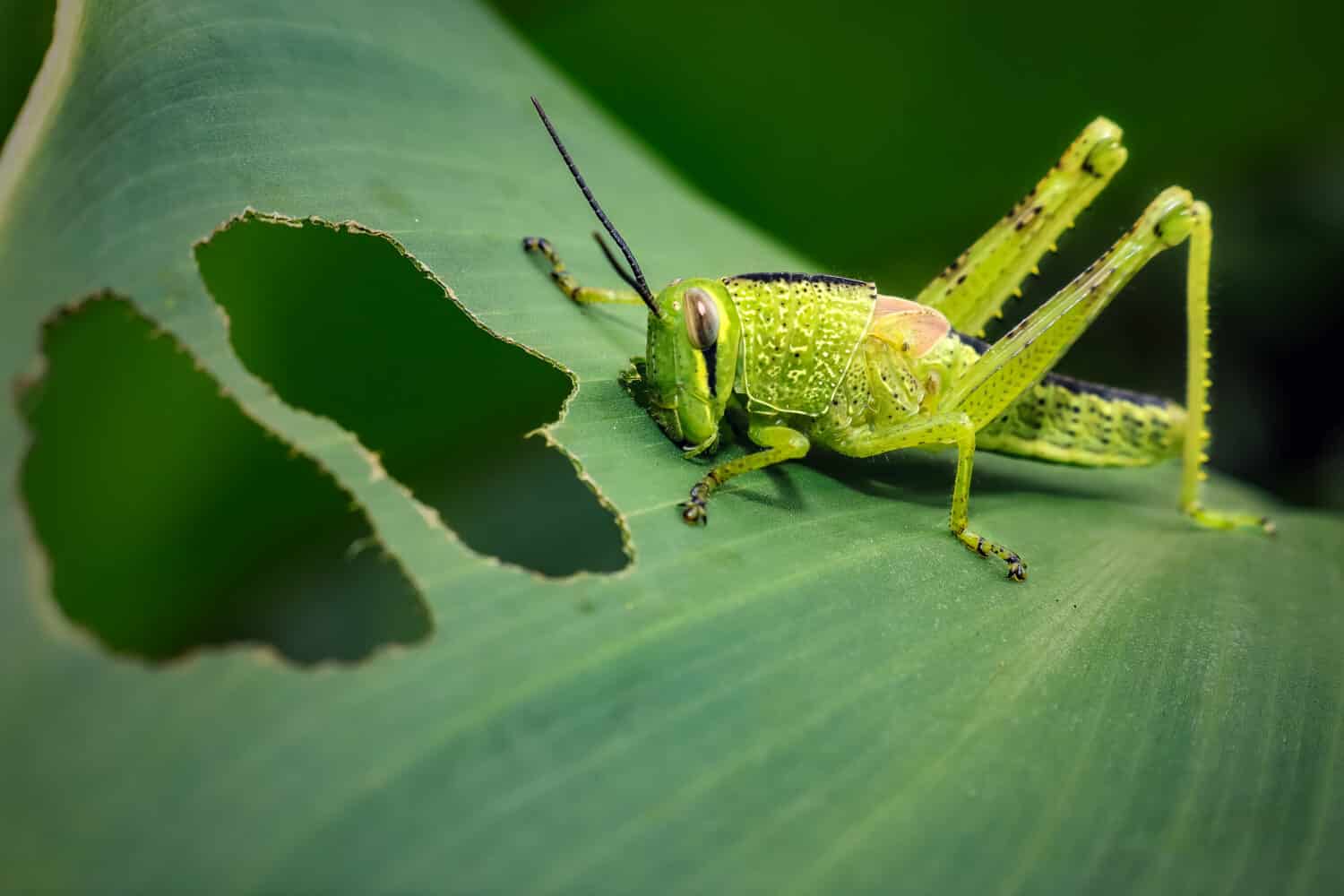
There are several non-toxic ways to keep grasshoppers from eating your garden.
©Kenz_Hanson/Shutterstock.com
Tilling the ground during fall clean-up or in early spring will kill any egg pods that have been deposited in the soil. Weeding early and often will eliminate an easy food source for nymphs and adults and discourage them from consuming your kale and other edibles.
Frequently Asked Questions
What Are Baby Grasshoppers Called?
Grasshoppers have three life cycles, egg, nymph, and adult. That makes a baby grasshopper a nymph.
What Is the Difference between a Grasshopper and a Locust?
As experts explain it, “locusts are always grasshoppers, but grasshoppers are not always locusts.” The difference is in how they behave. When conditions allow large numbers of grasshoppers to hatch, they can “swarm,” becoming locusts.
How Long Have Grasshoppers Been on Earth?
Fossils indicate that primitive grasshoppers evolved long before the dinosaurs, around 300 million years ago.
Are Grasshoppers Dangerous?
Unless you’re a tasty plant, grasshoppers pose no threat.
Are Grasshoppers Safe to Eat?
Humans have been consuming grasshoppers for a very long time. Now, insects, especially grasshoppers, are becoming popular dishes, both to feed the hungry and the experimental snacker. Grasshopper-based dog foods are also on the market.
How Many Baby Grasshoppers Can One Female Produce?
A lone female grasshopper can lay hundreds of eggs during her lifetime. They begin reproducing soon after becoming adults and live for only a few months.
The photo featured at the top of this post is © Lemonade Serenade/Shutterstock.com
Thank you for reading! Have some feedback for us? Contact the AZ Animals editorial team.







